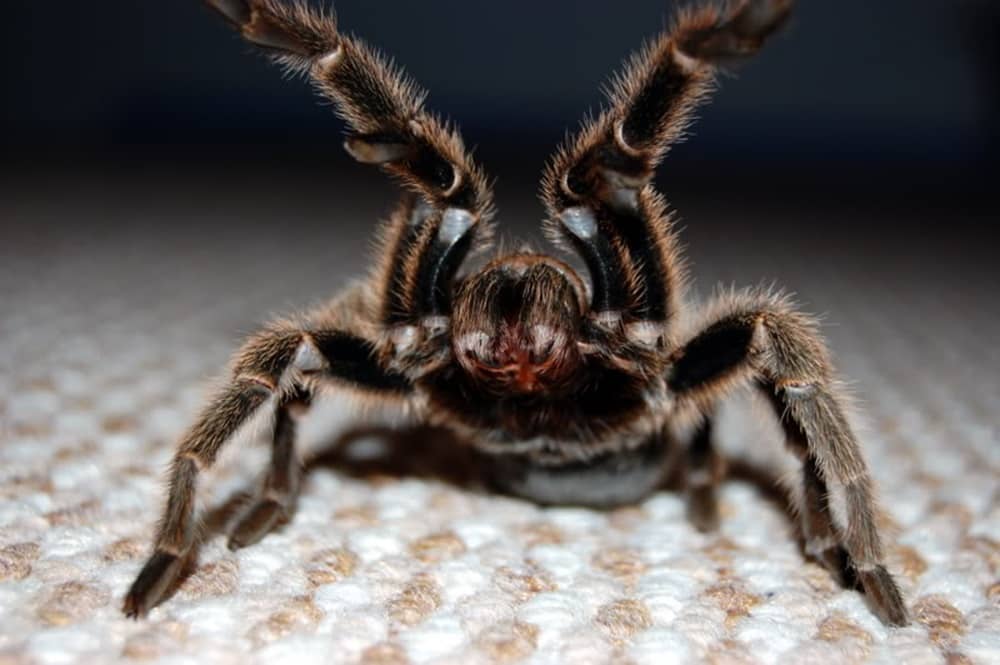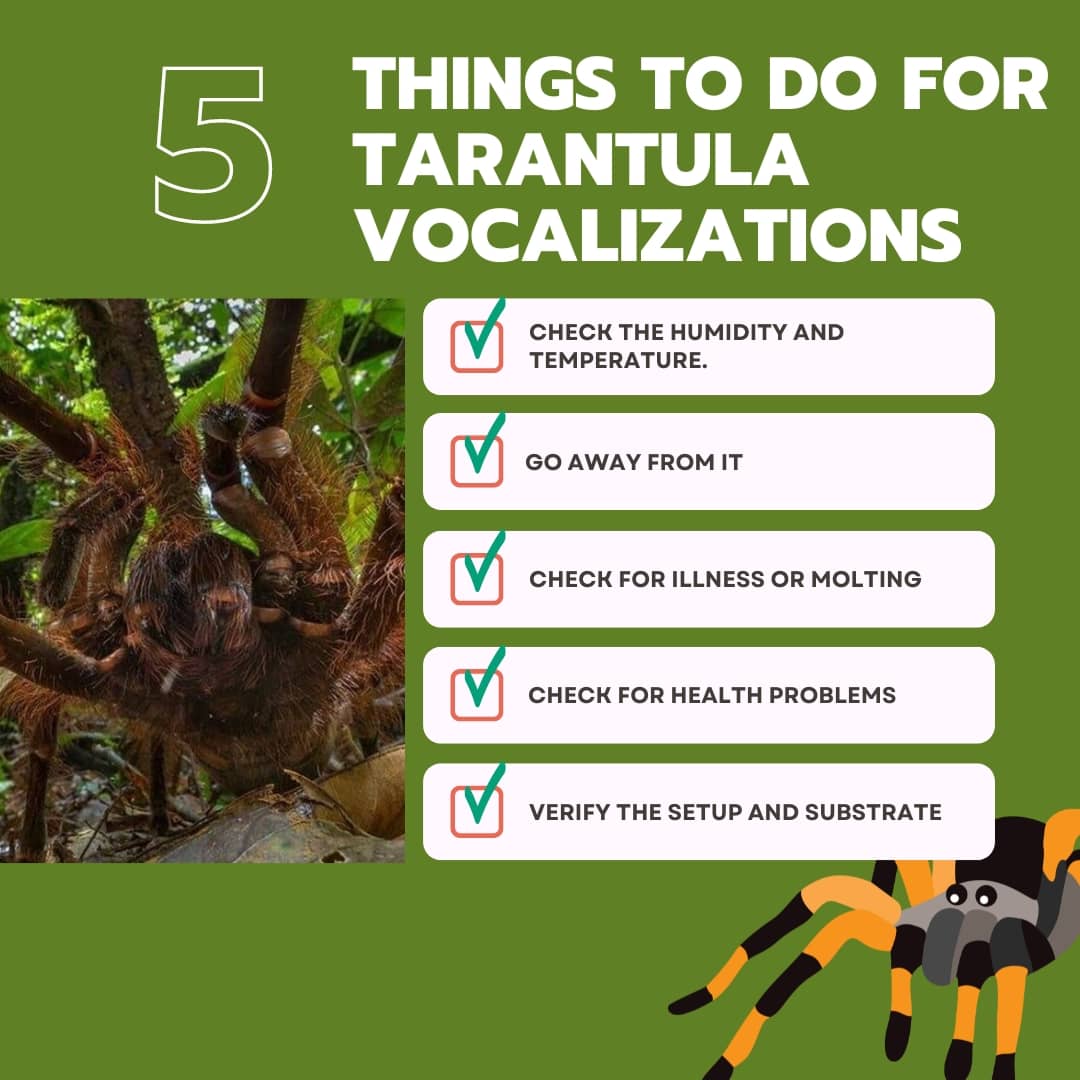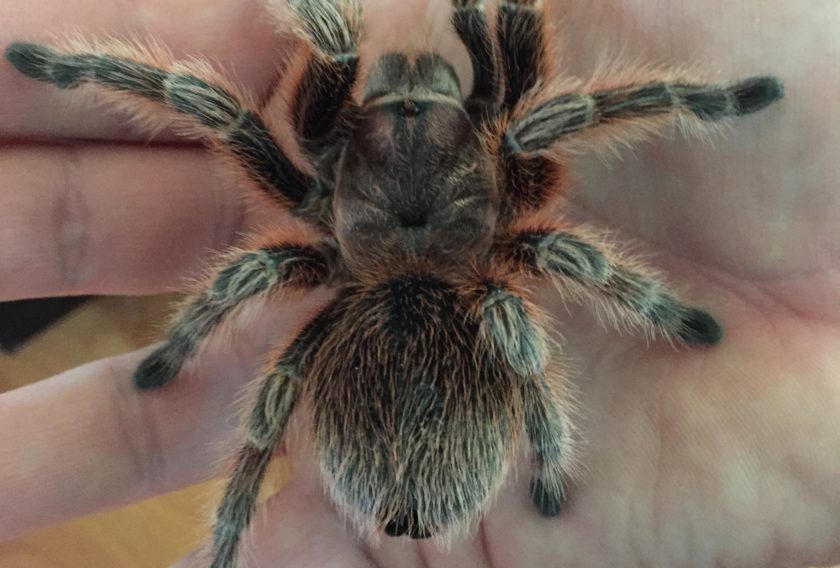Tarantula vocalizations are the sounds produced by a tarantula in different situations. Tarantulas don’t have vocal cords, so they make sounds in different ways to express themselves. The vocalizations of tarantulas are indicative of a state of unease, fear, or rage.

Tarantulas are a fascinating class of large, hairy spiders classified in the Theraphosidae family. They are characterized by having their legs as massive as 12 inches (30 cm) across, covered with long hairs that can be brown or black but also bright red, blue, and green.
Noises in Silence: Tarantula Vocalizations
Whereas most people view tarantulas as silent creatures, they have surprisingly developed various noises. Such sounds are sometimes only visible but quite crucial in communication and survival.
Stridulation
Process: A Rubbing Noise Mechanism: One classic way that tarantulas can produce sound is through stridulation. This typically involves rubbing one part of the body against another to make noise. In tarantulas, the most common stridulatory organs are the chelicerae (pincer-like appendages near the mouth) and the pedipalps (appendages similar to legs but located near the mouth).

Purpose: Stridulation may be used for any or all of the following purposes:
Warning signals: Tarantulas may stridulate to scare away predators or competitors. The noise scares off the antagonist with the threat that the tarantula will begin defending itself.
Mating ritual: Males tarantulas when mating will stridulate to entice females. The noise might describe the species and may signal readiness to mate.
Territorial disputes: Tarantulas use stridulation to lay down or protect their territory. The sound may help in the declaration of supremacy over others.
Abdominal Drumming
Process: Another method that tarantulas are known to produce noise is through abdominal drumming. This process entails tightening the abdomen in a rhythmic thumping or drumming noise.
Purpose: Abdominal drumming can serve many purposes, such as
Communication: Tarantulas can drum their abdomens as their communication method to others. The noise can be a sign of aggression, submission, or a will to mate.
Distress signals: In some instances, some tarantulas may drum their abdomens as a distress signal in case they are hurt or threatened
Hissing
Mechanism: There are several types of tarantulas that hiss by forcing air through their spiracles or their breathing holes.
Purpose: Hissein is one of the defense mechanisms usually instigated to scare away predators. The noise is threatening and might make the predator retreat.
Vibrations
Mechanism: Tarantulas can also convey messages using vibrations. They have specific hairs on their legs, which enable them to detect vibrations. In addition, they can communicate through vibrations since they can tap their legs on the ground to create vibrations.
Purpose: Vibrations serve various purposes, among which are:
Hunting: Tarantulas can sense prey by perception of vibrations.
Communication: A tarantula can use vibrations to communicate with other tarantulas. It may be specifically useful when they are working their way through dark or underground spaces where visual cues have little use.
Common Species that stridulate
Although not all tarantulas stridulate, the following species are more likely to do so:
- Birdeater Goliath (Theraphosa blondi)
- Grammostola rosea, or (the Chilean rose tarantula)
Depending on the species and the circumstance, stridulation can vary in both intensity and frequency.
The Reasons for Stridulation—Tarantula Vocalizations
The main purpose of tarantula “vocalizations” is defense; they aim to:
Deter Predators: When a tarantula perceives a threat, its sounds serve as a warning signal.
Notify Other Tarantulas: Stridulation can occasionally be used by tarantulas to communicate with one another, especially during mating rituals. The first step in the procedure is for males to drum their front leg-like appendages, called pedipalps, on the ground. This creates vibrations that let the female know he is not a predator or food, but rather that he is “knocking” on the doors of love in order to reproduce.
Threat Display: The sound intensifies the tarantula’s aggressive display when paired with other defensive actions like extending its front legs and showing its teeth.
Defense Mechanisms
Tarantulas have several defense mechanisms to protect them from predators:
Urticating hairs:
Most species of tarantulas have urticating hairs on the abdomens that they can flick up into the air and which may irritate or even harm the attackers.
Agonistic posture:
A threatened tarantula will raise its front legs and spread its fangs in an aggressive presentation.
Venom:
Although venom from most tarantulas is non-lethal to man, some of it can cause a little pain and swelling at the site of the bite.
What Should You Do When Your Tarantula Is Making Noises?
Examine Your surroundings
Look for any disruptions. Verify that the tarantula is not being stressed by any outside stimuli, such as bright lights, loud noises, or abrupt movements.
Check the humidity and temperature.
Make sure the circumstances in the enclosure are appropriate for the species of tarantula you have. If the conditions in their habitat are not optimal, tarantulas may get upset.
Go Away from it
Tarantulas may stridulate to alert other creatures or you. Give your tarantula some room and don’t handle it until it stops making noises.
Check for Illness or Molting
Before molting, some tarantulas may become more wary or disturbed. Watch for pre-molt symptoms, including dulling of color or decreased activity.
Check for Health problems
Even though noises don’t typically indicate disease, examining your tarantula for any obvious wounds or mobility problems is always a good idea.
Verify the setup and substrate
Make sure the tarantula has ample hiding places and a cozy substrate for its lair. It may grow anxious and exhibit defensive actions if it feels exposed.
Seeking additional guidance from a veterinarian with experience treating arachnids is advisable if the noise continues or appears out of the ordinary.

Frequently Asked Questions
Question 1: Do tarantulas make vocal noises?
Answer: Tarantulas lack vocal cords like mammals, and therefore do not make sounds produced from their vocal cords. However, they do produce some sounds by rubbing their legs or drumming their abdomen.
Question 2: Do tarantulas respond to sounds?
Answer: Tarantulas do not have ears or audible cortex, but they do respond to vibrations. Their legs are covered in incredibly sensitive hairs that detect air displacement in response to sound.
Question 3: What kind of noise does a tarantula make?
Answer: Tarantulas produce a “hissing” sound when they brush their pedipalps and bristly front legs together.
Question 4: Can a tarantula bite me when it is “hissing”?
Answer: Tarantulas that produce a “hissing” sound can be in a state of stress. You should not approach or touch it at this time as there is a high possibility of biting.
Question 5: Are tarantulas dangerous?
Answer: There are some tarantulas in the pet trade that have venom that is not deadly but that can make you sick. However, some tarantulas are docile and beginner-friendly, such as Chaco golden knee.
Conclusion:
Although not exactly known for their musical talents, tarantulas have managed to develop some surprisingly effective sounds that characterize the surprising repertoire involved in their communication and survival. Knowing this, we can better appreciate the complexity and diversity of tarantula behavior.


